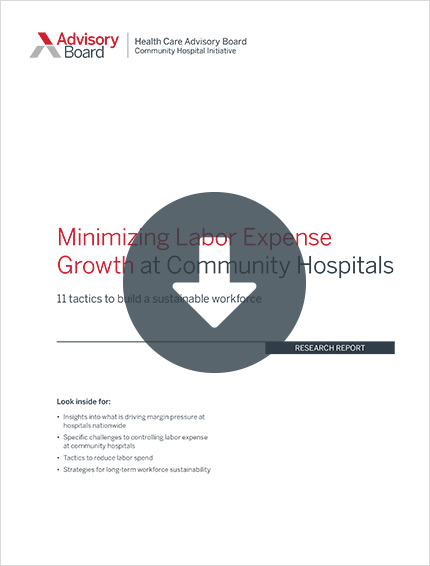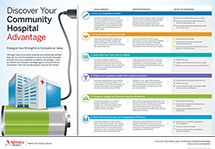Auto logout in seconds.
Continue LogoutRead Advisory Board's take: How can rural hospitals maintain financial health?
In every year since 2011, more hospitals have closed than opened—many of which were in rural communities. While this trend can lead patients to greater quality care, particularly when closures occur in areas that already have good hospital coverage or when they involve lower-quality hospitals, it also can have significant health consequences on the local population, Austin Frakt writes for the New York Times' "The Upshot."
The effects of closing hospitals
Almost 90 rural hospitals have closed since 2010, Frakt writes, many of which are the only hospitals for miles. According to a June report to Congress from the Medicare Payment Advisory Commission, about one-third of the 67 hospitals that have closed since 2013 were over 20 miles from the next closest hospital.
This has left many rural communities without access to certain specialists, Frakt writes. A study published last year in Health Affairs found that over half of rural communities no longer have obstetric services, and another study published in Health Services Research found that these closures increase the distance pregnant women have to travel for delivery.
Those gaps in specialty care can have significant implications. Another study published this year in JAMA found that counties without obstetric units are more likely to see higher-risk, preterm births. According to Katy Kozhimannil, an associate professor and health researcher at the University of Minnesota who co-authored all three studies, "What's left are maternity care deserts in some of the most vulnerable communities, putting pregnant women and their babies at risk."
Obstetrics isn't the only specialty in short supply in rural communities, Frakt writes. Care for mental health and substance misuse are the most likely to be sparse after rural hospital closures.
Trauma centers have also been rapidly disappearing in rural areas since 2001, according to a study in Health Affairs. As a result, travel time for trauma cases has increased, as has the risk of adverse outcomes, including death, Frakt writes.
A separate study found that increased travel time to hospitals was correlated with higher mortality rates for coronary artery bypass graft patients.
Hospital closures also have a noticeable economic effect, Frakt writes. A study published in Health Services Research found that per capita income falls about 4% when a community loses its only hospital, and unemployment increases by 1.6 percentage points.
Not every closure is a terrible thing for a community, however, Frakt writes. Some closings occur in areas that have good hospital coverage, and others involve hospitals with poorer quality care, which can lead patients to higher-quality facilities that can offset the negative effects of increased travel time.
Karen Joynt Maddox, a cardiologist and health researcher with the Washington University School of Medicine in St. Louis, said, "There are real trade-offs between consolidating expertise at larger centers versus maintaining access in local communities. The problem is that we don't have a systematic approach to determine which services are critical to provide locally, and which are best kept at referral centers."
Why hospitals are closing
There are a number of factors that have led to the uptick in hospital closures, Frakt writes, including shrinking rural populations and increased hospital consolidation. People are also using hospitals less frequently, Frakt writes, as more services head to outpatient settings rather than inpatient ones. Plus, as technology improves, those who do see inpatient care are being cared for more rapidly.
Another contributing factor is the decision by many states to opt out of Medicaid expansion under the Affordable Care Act (ACA), Frakt writes. He cites research that’s shown the majority of recent hospital closings have been in states that did not expand Medicaid. The reason is likely twofold, Frakt writes. He notes that the level of uncompensated hospital care—which is often higher in rural areas—fell substantially in states that expanded Medicaid.
States that opted into Medicaid expansion also saved money, according to a Commonwealth Fund Issue brief. Researchers from the Northwestern Kellogg School of Management that found that states that opted into Medicaid expansion saved $6.2 billion in uncompensated care.
According to Richard Lindrooth, a professor at the University of Colorado School of Public Health and lead author on a study looking at Medicaid expansion and hospitals' finances, "hospitals' futures hang in the balance" of whether states decide to expand Medicaid (Frakt, "The Upshot," New York Times, 10/29).
Advisory Board's take


Rob Lazerow, Managing Director, Health Care Advisory Board andAndrea Martin, Senior Consultant, Health Care Advisory Board
This article reiterates a problem that health care leaders have known for a long time: Many rural hospitals are unfortunately struggling to remain financially stable. Rural hospitals are increasingly closing—and even those that remain open find their margins tightening each year.
While it's certainly important for all hospitals to focus on comprehensive margin management, it's vital for rural hospitals. As a result of the ongoing decline in inpatient volumes and price deceleration, revenues for rural hospital are shrinking. Continuing to operate with status quo financial performance is untenable.
“Continuing to operate with status quo financial performance is untenable.”
The recent elections—specifically voters electing to expand Medicaid for an estimated 300,000 people in Idaho, Nebraska, and Utah—could offer some relief for rural hospitals. These hospitals typically treat a large portion of Medicare and Medicaid beneficiaries—but still have high uncompensated care costs. Medicaid expansion can help reduce the amount of uncompensated care. So far, states that expanded Medicaid have experienced lower uncompensated costs and fewer rural hospitals closures.
However, this doesn't mean that rural hospitals are out of the woods. They still have to be cost-disciplined, as recent revenue growth is simply no longer sufficient to offset operating costs. Specifically, our research has found that rural hospitals should focus on two priorities:
- First, they must be laser-focused on minimizing labor expense growth. Labor is the largest expense for community hospitals and these costs are accelerating rapidly. The annual growth rate of labor expenses at small, stand-alone hospitals was 3.3% in 2013—but more than doubled to 8.0% in 2016.
- Second, they must rebase external spending, especially in supplies and services. Despite recent efforts by many community hospital leaders, our research suggests that organizations still have significant opportunity to improve unfavorable contract terms and prevent unnecessary supply waste. By some estimates, the average 300-bed hospital can save $1.5 million on surgical supply waste and anywhere from 10% to 35% from renegotiating contract terms.
We know that the challenges facing rural hospitals are intensifying, and whether you're the leader of an independent rural hospital, or manage rural hospitals as part of a large system, we've created a wide range of tools to help. We've created a new Community Hospital Compendium which compiles all of our resources for both community hospitals and critical access hospitals (CAHs).
For community hospitals executives, we'd suggest looking at our research reports on minimizing labor expense growth, minimizing care variation, and the community hospital advantage, which collectively provide a wealth of tactics you can use to lead your organization through tough market transitions.
For both community hospitals and critical access hospitals, we've also created customized benchmarking tools which gives you instant access to easy Medicare benchmarking for financial, operational, and quality data against other small, independent hospitals or CAHs.
Don't miss out on the latest Advisory Board insights
Create your free account to access 1 resource, including the latest research and webinars.
Want access without creating an account?
You have 1 free members-only resource remaining this month.
1 free members-only resources remaining
1 free members-only resources remaining
You've reached your limit of free insights
Become a member to access all of Advisory Board's resources, events, and experts
Never miss out on the latest innovative health care content tailored to you.
Benefits include:
You've reached your limit of free insights
Become a member to access all of Advisory Board's resources, events, and experts
Never miss out on the latest innovative health care content tailored to you.
Benefits include:
This content is available through your Curated Research partnership with Advisory Board. Click on ‘view this resource’ to read the full piece
Email ask@advisory.com to learn more
Click on ‘Become a Member’ to learn about the benefits of a Full-Access partnership with Advisory Board
Never miss out on the latest innovative health care content tailored to you.
Benefits Include:
This is for members only. Learn more.
Click on ‘Become a Member’ to learn about the benefits of a Full-Access partnership with Advisory Board
Never miss out on the latest innovative health care content tailored to you.


